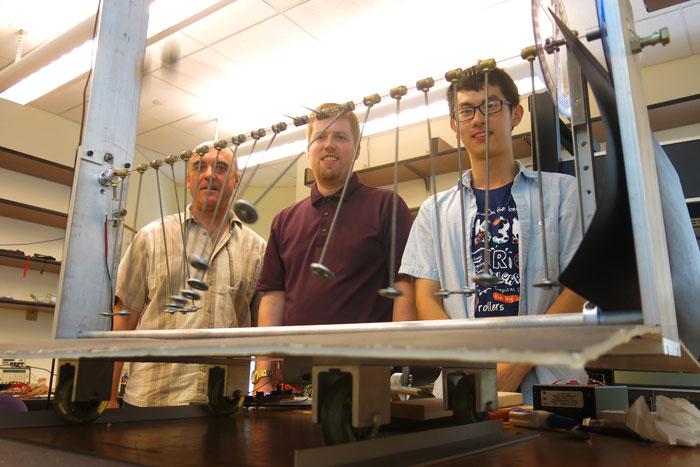Rogue Pendulum

The spring-coupled pendulum chain, built by Jacky Han '17, demonstrates the breakup of the pendula's uniform swinging motion, the descent into chaos and then the emergence of a new kind of order. Photo by Tony Moore.
Summer student-faculty research project lives at the interface of mechanical engineering, physics and applied math
by Tony Moore
There’s an experiment going on in a stuffy lab in Tome right now, and it’s playing out with two physicists, a student and a gyrating table rigged with a pendulum setup that looks a lot like a Newton’s cradle.
Here’s the idea, according to Associate Professor of Physics & Astronomy Lars English: “These pendula are linked up with springs, so when one moves the next ones will move as well,” he begins, outlining an experiment that seems at first simple and then veers into the complex. “What we can show is that there is a pattern-forming process whereby a sharply localized spacial pattern emerges at certain driver frequencies.”
The driver is the shaking table; the frequencies are the speeds at which the table shakes; the sharply localized pattern is revealed in one pendulum swinging wildly out of sync with the others (see video below). Outside the lab, the experiment, which in the end is about moving energy, could be used for developments in areas such as data storage, “stuff you can move without moving atoms around,” English says. “There are some applications, but they're usually negative in that you might want to avoid or suppress this kind of thing.”
As an example of spontaneous localization of energy (and one people would surely want to avoid), English points to “rogue waves," soliton-like phenomena in water that occasionally form and are responsible for capsizing even large deep-sea ocean liners.
But back to the lab: Why doesn’t the shaking table make all the pendula swing in unison?
“It's counterintuitive, because obviously the table affects all the springs and pendula in the same way, because they're all part of the table,” English says. “Yet only one of them is responding, and the other ones are basically stationary, which is called intrinsic localized mode, or a discrete breather.”
The driver (aka table—which English calls a spring-coupled pendulum chain) was built by Jiahao (Jacky) Han ’17 (physics, computer science). He also built an Arduino mechanism to run some computations on the table as it reads the driver’s frequency.
“We've been relying on Jacky’s computer science skills in a big way,” English says. “He built that device in record time. It took him a day or two to figure it out. Very fast.”
Also in the lab is Professor Faustino Palmero, visiting from the University of Seville, Spain. His theory—one that predicted the counterintuitive nature of the pendula reactions—prompted the entire experiment, which has now led the group to write a paper that's out for review.
Learn more
Published August 14, 2015